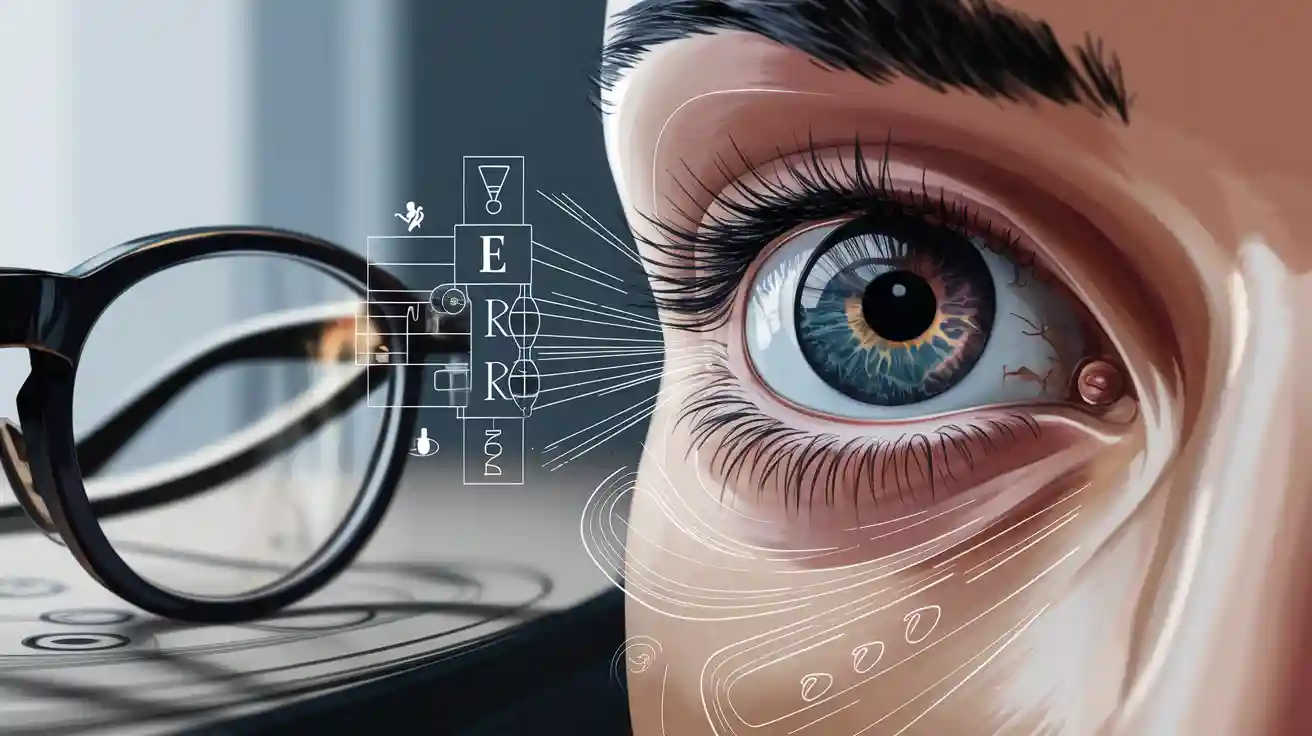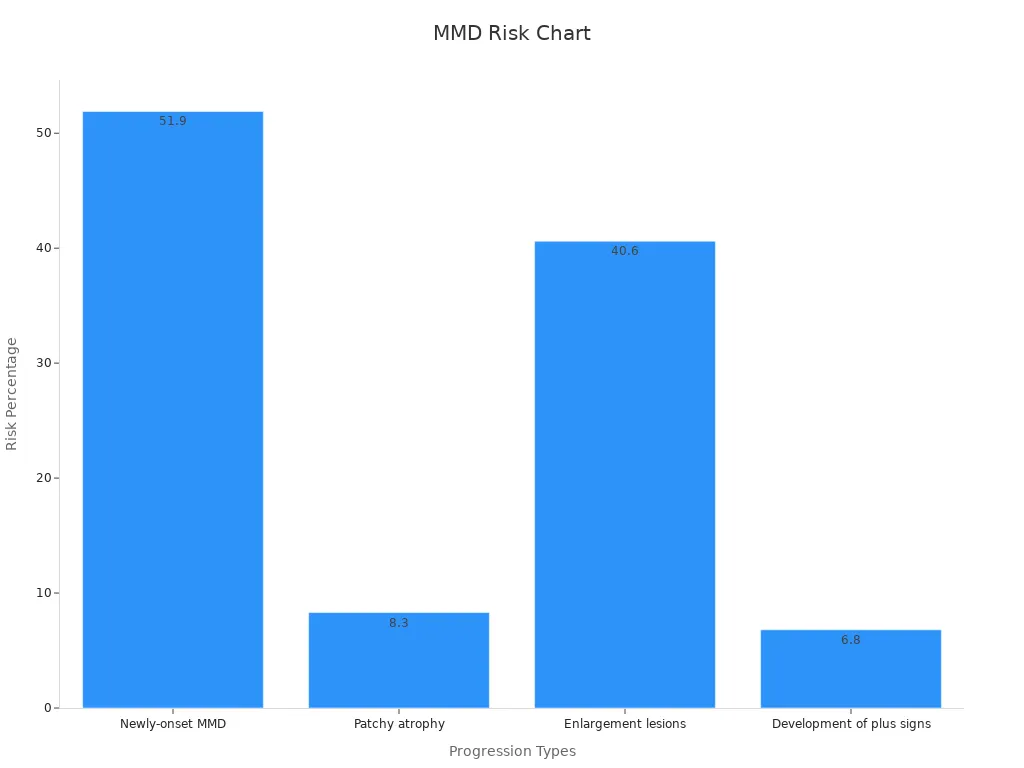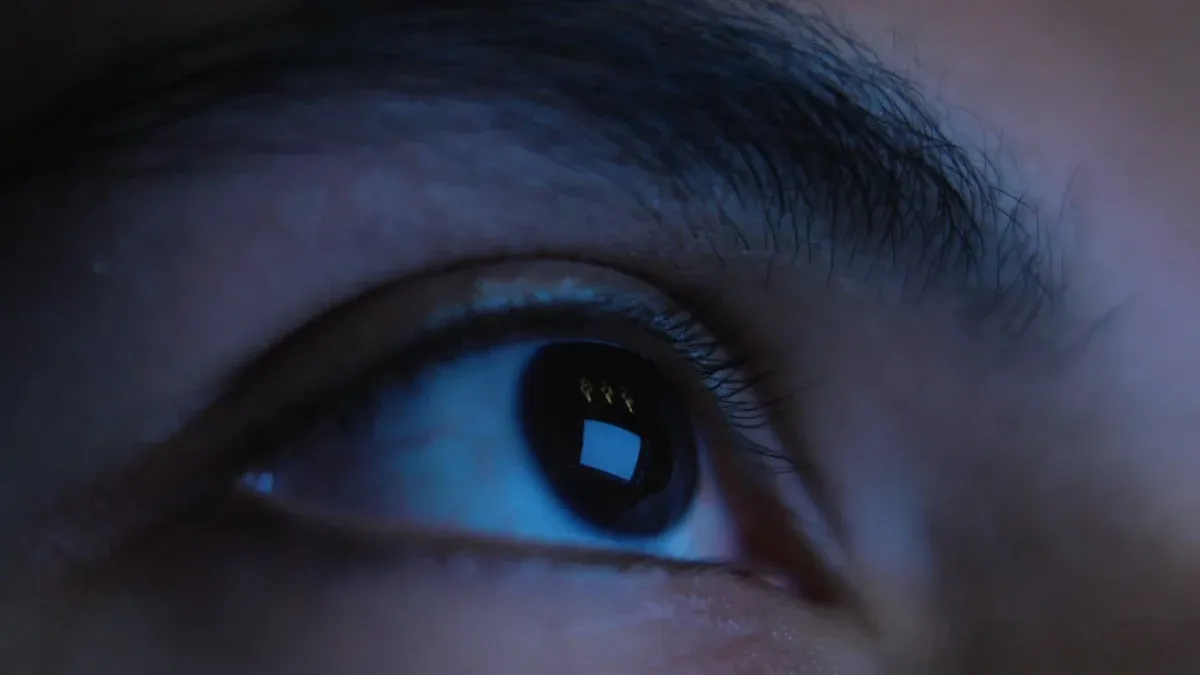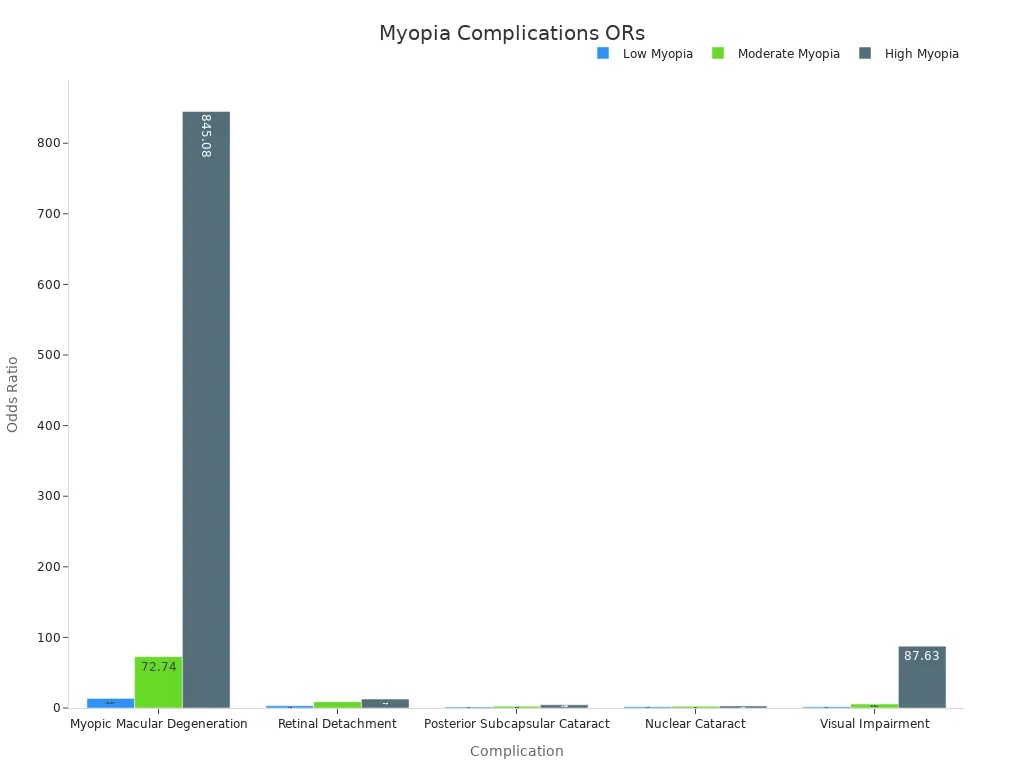
High myopia brings serious eye health problems. You face a much higher risk for cataracts, glaucoma, retinal detachment, and myopic maculopathy. These complications can cause blurred vision, vision blurry episodes, or even permanent vision loss. Studies show myopic maculopathy is a leading cause of vision loss in people with severe nearsightedness.
Prevalence of myopic maculopathy in high myopia ranges from 13.3% to 65.4%.
Each 1 diopter increase in myopia raises risk by 67%.
Nearsightedness affects your eyes for life. Myopia often starts in childhood. It can progress, so you need regular eye exams to catch changes early. Lifelong monitoring and proactive care help protect your vision from further damage due to myopia and its complications.
Key Takeaways
High myopia increases the risk of serious eye problems like cataracts, glaucoma, retinal detachment, and myopic maculopathy that can cause vision loss.
Regular eye exams help detect changes early and protect your vision from worsening complications.
Watch for sudden vision changes such as flashes, floaters, or dark spots and see an eye doctor immediately if they occur.
Managing risk factors like spending time outdoors, limiting screen time, and following your doctor’s advice can slow myopia progression.
Early and ongoing care improves long-term eye health and helps maintain your independence and quality of life.
High Myopia Complications
Cataracts
You face a much higher risk of developing cataracts if you have high myopia. Cataracts cause the lens in your eye to become cloudy, making it hard to see clearly. Studies show that people with high myopia often develop cataracts about ten years earlier than those without myopia. Nuclear and posterior subcapsular cataracts are the most common types in highly myopic eyes.
Cataracts appear earlier and progress faster in high myopia.
Nuclear cataracts make up over 70% of cataract cases in highly myopic eyes.
Axial length elongation (the eye grows longer) increases the chance of early cataract formation.
Cataract surgery is more difficult in high myopia and can lead to more complications.
Note: If you notice sudden blurry vision, glare, or trouble seeing at night, you should see your eye doctor soon.
Multiple studies confirm that high myopia leads to more severe cataracts and a greater need for surgery. The risk of poor vision after surgery is higher if you have macular atrophy or other eye changes from myopia.
Glaucoma
High myopia increases your risk of glaucoma, a disease that damages the optic nerve and can cause permanent vision loss. The risk of glaucoma rises as myopia becomes more severe. Structural changes in highly myopic eyes, such as globe elongation and thinning of the nerve fiber layer, make the optic nerve more vulnerable.
People with high myopia have about a 1.7 to 2.5 times higher risk of glaucoma than those with low myopia.
Every extra diopter of myopia increases your risk of glaucoma by about 20%.
Glaucoma often progresses faster in myopic eyes.
Study Type |
Key Findings |
|---|---|
Meta-analysis (15 studies) |
|
Dose–response analysis |
20% increased risk per diopter of myopia |
Clinical study |
Glaucoma prevalence rises from 12.2% to 42.1% as axial length increases |
Alert: Watch for symptoms like sudden loss of vision, eye pain, or seeing halos around lights. These may signal acute glaucoma and need urgent care.
Retinal Complications
High myopia stretches your retina, making it thin and fragile. This stretching leads to associated retinal complications, including retinal detachment, tears, and holes. Retinal detachment is one of the most serious risks you face with high myopia.
You have a 5 to 6 times higher risk of retinal detachment compared to people with low myopia.
Lattice degeneration, a type of retinal thinning, occurs in up to 20% of young people with high myopia.
Retinal breaks, tears, or detachments happen in about 4.4% to 4.8% of high myopes.
The risk of retinal detachment after cataract surgery is much higher in high myopia (up to 9.2%) than in the general population (less than 1%).
A clinical study found that retinal detachment happens much more often in eyes with previous retinal tears, especially in high myopia. The risk remains high even years after the first problem.
Tip: If you see sudden flashes of light, a shower of floaters, or a shadow in your vision, get emergency help right away. These are signs of retinal detachment and can lead to permanent vision loss if not treated quickly.
Myopic Maculopathy
Myopic maculopathy is a sight-threatening disease that affects the central part of your retina, called the macula. This condition is unique to high myopia and is a leading cause of vision loss in people with severe nearsightedness.
Myopic maculopathy becomes more common and severe as you age and as your myopia worsens.
About 20% of people with high myopia show progression of myopic maculopathy over 10 years.
Key risk factors include longer axial length, thinner choroid, older age, and higher systolic blood pressure.
Lacquer cracks in the retina signal a higher risk of progression.

Myopic maculopathy can cause irreversible vision loss. You may notice straight lines look wavy, or you may lose central vision. These changes often happen slowly, but sometimes vision can worsen quickly.
Callout: If you notice any sudden changes in your central vision, such as distortion or a dark spot, contact your eye doctor immediately.
High myopia leads to anatomical changes like thinning of the retina and choroid, which increase your risk for myopic maculopathy and other associated retinal complications. Early detection and regular monitoring help lower your risk of sight threatening complications.
Long-Term Complications and Risks
Pathologic Myopia
Severe myopia can cause permanent changes inside your eye. Over time, you may develop long-term complications that affect your vision for life. Pathologic myopia means your eye has changed so much that it now faces extra risks for blinding eye conditions. These changes include thinning of the retina, stretching of the eye wall, and damage to the blood vessels in the back of your eye.
Younger people with early onset myopia often see faster changes. As you get older, the risk of these changes continues, especially if you have severe myopia. Studies show that even adults with high myopia can keep progressing. The table below shows how myopia can change over time:
Study Description |
Population |
Duration |
Key Findings |
|---|---|---|---|
2-year cohort study |
657 highly myopic Chinese patients (age 7-70) |
2 years |
Myopic shift and eye elongation in all ages; fastest in ≤20 years; adults with severe myopia kept progressing |
40-year Danish study |
36 adolescents with ≤−6.00 D |
40 years |
Biggest changes in first 10 years; long-term risk remains |
Japanese case series |
29 children under 15 (mean −9.6 D) |
>20 years |
63% developed pathologic myopia as adults; early changes predict future problems |
You may notice changes like a tessellated fundus or chorioretinal atrophy. These signs mean your eye is at higher risk for blinding eye conditions. If you do not catch these long-term complications early, you could face irreversible vision loss.
Note: Regular eye exams help you find these changes before they cause permanent damage.
Choroidal Neovascularization
Choroidal neovascularization (CNV) is one of the most serious long-term complications of myopia. CNV happens when new, abnormal blood vessels grow under your retina. These vessels can leak fluid or blood, causing sudden and severe vision problems. CNV is a leading cause of blinding eye conditions in people with pathologic myopia.
Evidence Aspect |
Details |
|---|---|
Risk factors |
Older age, longer eye length, severe myopia, choroidal thinning, lacquer cracks |
Impact |
Rapid progression, severe vision loss, high recurrence rate |
Treatment |
Anti-VEGF therapy is standard, but long-term recurrence is common |
You face a higher risk for CNV as you age or if your myopia is more severe. About 10% of people with high myopia develop CNV over 10 years. If you have CNV, you may notice sudden vision changes or dark spots in your central vision. Without quick treatment, this long-term complication can lead to permanent vision loss.
Alert: If you see sudden changes in your vision, contact your eye doctor right away. Early treatment can help prevent blinding eye conditions.
Long-term complications from myopia can change your life. You need to stay alert for new symptoms and keep up with regular checkups to lower your risks.
Long-Term Impact of Myopia on Daily Life

Vision Impairment
Living with high myopia can change how you see the world every day. You may notice that simple tasks, like reading signs or recognizing faces, become harder. Many people with high myopia struggle with blurry vision, poor contrast, and trouble seeing in bright light or glare. These problems can make it difficult to move around safely or do things on your own.
People with severe myopia often need help with daily activities.
You might find it hard to read, cook, or use a computer.
Some people need special tools or support to stay independent.
A large study showed that people with pathologic myopia have lower quality of life scores. They often report more problems at school, work, and home. Even with glasses, you may still have trouble seeing clearly because of changes inside your eye. Over time, the long-term impact of myopia can limit your independence and reduce your ability to enjoy daily life.
Tip: If you notice new problems with your vision, talk to your eye doctor. Early help can make a big difference.
Emotional and Social Effects
The impact of vision problems goes beyond just seeing. You may feel frustrated or sad when you cannot do things you used to enjoy. Many people with high myopia experience stress, anxiety, or even depression because of vision changes. Losing some independence can make you feel isolated or worried about your future.
You might avoid social events or feel left out at school or work.
Some people feel embarrassed about wearing thick glasses or using aids.
Emotional support from family, friends, or support groups can help you cope.
Studies show that vision loss can affect your mood and motivation. You may go through stages of denial or acceptance as you adjust. Talking to others who understand your challenges can make you feel less alone. Remember, asking for help is a sign of strength.
Note: Taking care of your mental health is just as important as caring for your eyes.
Monitoring and Prevention
Regular Eye Exams
You need regular eye exams to protect your vision if you have high myopia. These exams help your doctor find problems early, even before you notice symptoms. Early detection gives you the best chance to stop the progression of myopia and avoid serious complications. Comprehensive eye exams are especially important for children. Studies show that detailed exams, not just frequent ones, help manage myopia better and raise awareness about eye health.
Professional groups recommend vision screening for children every one to two years. The American Academy of Pediatrics suggests annual screenings from ages 3 to 6, then every two years. Early and regular exams help spot changes in children's vision and catch the progression of myopia before it leads to bigger problems. Large studies show that starting regular eye exams at a young age helps predict and prevent high myopia. Exams can also catch emergencies like retinal detachment early, which can save your sight.
Tip: Schedule regular, thorough eye exams for your children. Early checks help prevent vision loss and support healthy eye growth.
Managing Risk Factors
You can lower your risk of long-term complications by managing each risk factor linked to high myopia. Start by learning about your family history, as genetics play a big role. Encourage your children to spend more time outdoors, since this helps prevent the progression of myopia. Limit screen time and near work, and remind children to take breaks every 30 minutes when reading or using devices.
Doctors use several tools for myopia management. These include low-dose atropine drops, special contact lenses, and glasses designed to slow the progression of myopia. Each child needs a plan based on their risk factor profile, age, and how quickly their myopia is changing. Regular follow-up visits let your doctor adjust the plan as needed.
Get baseline measurements like axial length and refraction for your children.
Use protective eyewear to avoid eye injuries, which are a risk factor for retinal problems.
Some surgeries, such as LASIK, may not be safe for children with high myopia due to the risk of complications.
Stay informed about new research and guidelines for myopia management.
Note: Early action and ongoing care help reduce the risk factor for vision loss. Work with your eye doctor to create a plan that fits your child's needs.
You face higher risks for vision loss from high myopia, including cataracts, glaucoma, retinal detachment, and myopic macular degeneration. Early detection and regular monitoring help you catch problems before they become severe.
Over 2 billion people worldwide have vision loss from late detection.
Early treatment and lifestyle changes slow myopia progression and protect your sight.
Personalized care plans and new treatments improve long-term outcomes.

Stay alert for changes in your vision and see your eye doctor right away if you notice any warning signs. Proactive care keeps your eyes healthier for life.
FAQ
What symptoms should make you see an eye doctor right away?
If you notice sudden flashes, many new floaters, or a dark shadow in your vision, see your eye doctor immediately. These signs may mean retinal detachment or other emergencies.
Can high myopia get worse as you get older?
Yes, your myopia can keep progressing, especially if you had early onset. Eye changes may continue into adulthood. Regular eye exams help track these changes and protect your vision.
Is LASIK safe for people with high myopia?
LASIK is not always safe for high myopia. You may face higher risks for complications, such as retinal detachment. Your eye doctor can help you decide if surgery is right for you.
How can you lower your risk of myopia complications?
Get regular eye exams.
Protect your eyes from injury.
Use treatments to slow myopia progression.
Spend more time outdoors.
Follow your doctor’s advice for managing risk factors.






